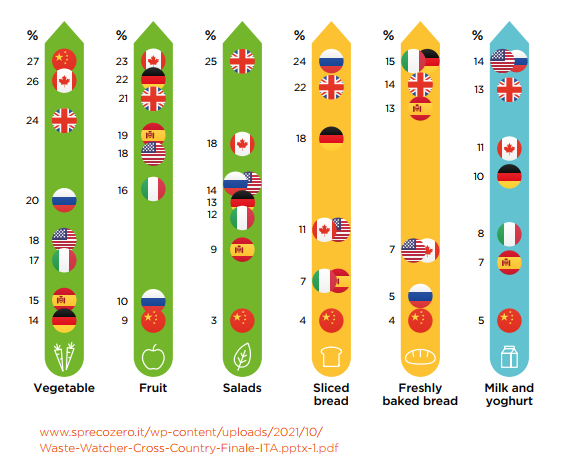The “FAO food wastage footprint impacts on natural resources’’ estimates that the global volume of food waste amounts to around 1.6 Gtons (1 Gton = a million tons), “of equivalent primary products”, while the edible part is 1.3 Gtons, out of an agricultural production of GGtons. According to this estimate the carbon footprint of food produced and not eaten is 3.3 Gtons of CO2 equivalent; if this was a country it would be third on the podium as a source of gas emissions, after the United States and China.
Things are no better on the ’blue’ podium. Globally, the water footprint - the consumption of surface and underground water resources - linked to food waste is around 250km³. a volume equivalent to three Lake Genevas. Regarding the land, the volume of food wasted in various ways needlessly takes up 1.4 billion hectares of soil, or almost 30% of the global agricultural area.
Food waste also negatively affects biodiversity, causing damage that is difficult to quantify. Certainly intensive farming, monocultures and the increasing agricultural exploitation of the soil are impacting natural and uncontaminated areas, with negative consequences for ecosystems. For all these reasons, food waste is associated with climate change.
The economic impact is no less shocking. The Barilla Foundation (Non sprechiamo! Let’s stop waste!), reports: food waste equals 2,600 billion US dollars a year, calculated thus: 1,000 billion for the value of lost products; the environmental costs of greenhouse gas emissions, loss of soil, water and biodiversity are valued at 700 billion; while the social costs linked to lack of food, such as damage to health and risk of conflict are estimated to be 900 billion. Last but not least, looking ahead, reducing food waste would decrease the pressure on agri-food production in anticipation of the increased demand which, it is estimated, will be needed to feed the global population in 2050.
THE TREND OF FOOD WASTE IN THE HOME
The first global survey of domestic waste is the Waste Watcher International Observatory on Food & Sustainability study, under the direction of Andrea Segre Professor of Agricultural Policy, International University of Bologna. Italy.The International Cross Country Waste Watcher report sketches a picture of current global food habits.
The survey took place in eight countries on a statistical sample of 8,000 people with 1,000 interviews per country.
What do we waste most?
All around the world, fresh and perishable foods - fruit, vegetables, dairy - are those which are most frequently wasted. Fruit and vegetables most specifically, with a weekly percentage of 42.6 grams of fruit per person in the USA, to 24.5 per person in Russia. Another ‘big waste’ is fresh bread: the USA is ahead again, with 38.3 grams, followed by the English with 33.8 grams, and Italy with 22.3 grams a week.
In families around the world, waste occurs for similar reasons: on average, 44% let food go out of date; 40% buy more than they need; and around 33% wrongly cook more than required. Of those interviewed, it is mainly the Chinese who let food go out of date (64%), buy too much food (61%), or cook too much (64%), while 72% say they do not like to use leftovers. Forgetting about the food they have bought is another bad habit that affects people in all the countries surveyed: one in two of the Italians. Spanish and Germans interviewed confessed to this, while the Canadians and British are even worse, respectively ‘guilty’ in 65% and 61% of cases.

.jpg?VGhlIFBlcmZlY3QgU2xvdC1pbijmraPnoa4pLmpwZw==)





































